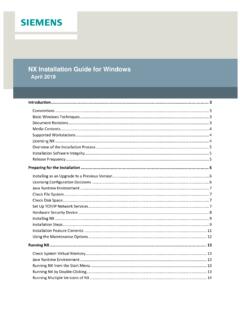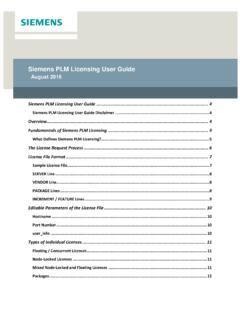Transcription of Getting Started with SNAP - Siemens
1 Getting Started with NX Open Revision February 2016. 2016 Siemens Product Lifecycle Management Software Inc. All rights reserved. Table of Contents Chapter 1: Introduction .. 1 Chapter 8: Simple Solids and Sheets .. 64. What Is NX Open .. 1 Creating Primitive Solids .. 64. Purpose of this Guide .. 1 Sections .. 65. Where To Go From Here .. 1 Extruded Bodies .. 67. Other Documentation .. 2 Revolved Bodies .. 68. Example Code .. 3. Chapter 9: Object Properties & 69. Chapter 2: Using the NX Journal Editor .. 4 NXObject Properties.
2 69. System Requirement The .NET Framework .. 4 Curve and Edge Properties .. 71. Typographic Conventions .. 4 Face Properties .. 74. Licensing .. 4. The Guide 5 Chapter 10: Feature Concepts .. 76. Example 1: Hello World .. 5 What is a Feature ? .. 76. Example 2: 6 Types of Features .. 76. Example 3: Creating Simple Geometry .. 8 Feature Display Properties .. 77. Example 4: Reading Attributes .. 9 Using Features and Bodies .. 78. Example 5: WinForms (The Hard Way) .. 11 Units .. 78. What Next? .. 14 Expressions.
3 79. Creating Expressions .. 81. Chapter 3: Using Visual Studio Express .. 15 Using Expressions to Define Features .. 82. Installing Visual 15. Installing NX Open Templates .. 16 Chapter 11: Assemblies .. 84. Licensing Issues Again .. 16 Introduction .. 84. Example 1: Hello World 16 The Obligatory Car 84. Example 2: Declaring Variables .. 19 Trees, Roots, and Leaves .. 84. Example 3: WinForms Again .. 20 Components and Prototypes .. 85. Example 4: Hello World Yet Again (the Hard Way) .. 23 Cycling Through An Assembly.
4 87. Example 5: Editing a Recorded Journal .. 25 Indented 88. Debugging in Visual Studio .. 28 Component Positions & Orientations .. 88. Object Occurrences .. 89. Chapter 4: The Visual Basic Language .. 29 Creating an Assembly .. 91. The Development 29 More Advanced Positioning .. 93. Structure of a Visual Basic 29 Changing Reference Sets .. 94. An Example Program .. 30 Other Topics .. 95. Lines of 31. Built-In Data Types .. 32 Chapter 12: Drawings & Annotations .. 96. Declaring and Initializing Variables.
5 32 96. Omitting Variable 33 Dimensions .. 97. Data Type 34 Notes .. 98. Arithmetic and 34. Logical Values & 35 Chapter 13: 99. Arrays .. 35 Cycling Through CAM 99. Other Types of Collections .. 36 Editing CAM Objects ..100. 36 CAM Views ..101. Enumerations .. 37 Creating a Tool ..102. 37. Decision Statements .. 38. Chapter 14: Block-Based Dialogs .. 103. Looping .. 38 When to Use Block-Based Functions and Subroutines .. 39 How Block-Based Dialogs Work ..104. Classes .. 40 The Overall Shared Functions .. 41 Using Block UI Styler.
6 105. Object Properties .. 41 Template Code ..106. Hierarchy & Inheritance .. 42 The initialize_cb and dialogShown_cb Event Handlers ..107. The apply_cb Event Handler ..107. Chapter 5: Concepts & Architecture .. 43 The update_cb Event Handler ..109. The Levels of NX Open .. 43 Callback More About .. 43 Precedence of Values ..110. The NX Open Inheritance Hierarchy .. 44 Getting More Sessions and Parts .. 44. Objects and Tags .. 45. Chapter 15: Selecting NX Objects .. 112. Factory Objects .. 46 Selection Dialogs.
7 112. Object Collections .. 47 SelectObject Blocks ..117. The Builder Pattern .. 47 Selecting Faces, Curves and Edges using Collectors ..119. Exploring NX Open By Journaling .. 49 Selection by Database Cycling ..121. The FindObject Problem .. 49 Chapter 16: 123. Mixing SNAP and NX Open .. 50. Exceptions ..123. Chapter 6: Positions, Vectors, and Points .. 52 Example: Unhandled Exceptions ..124. Point3d Objects .. 52 Handling an Exception ..125. Vector3d Objects .. 53 Exception Properties ..126. Points .. 53 NX Using Undo for Error Recovery.
8 127. Chapter 7: Curves .. 55 Avoiding Exceptions ..127. Lines .. 55 The Finally Block ..128. Associative Line Features .. 56. Arcs and Circles .. 56. Chapter 17: Troubleshooting .. 129. Associative Arc 58 Using the NX Log Conic Section Curves .. 59 Invalid Attempt to Load Library ..129. Splines .. 59 XXX is not a member of NXOpen ..130. Studio Splines .. 61 Unable to Load Referenced Sketches .. 62 Visual Studio Templates Missing ..131. Failed to Load Chapter 1: Introduction What Is NX Open NX Open is an Application Programming Interface (API) that lets you write programs to customize or extend NX.
9 The benefit is that applications created this way can often speed up repetitive tasks, and capture important design process knowledge. There is a broad range of NX Open functions, which provide capabilities like Creating part geometry, assemblies, drawings, and CAE and CAM objects Cycling through the objects in a part file, reading information or performing various operations on them Creating custom user interfaces that allow users to select objects and enter data Some typical applications of these functions are: Creating part geometry or drawings according to your local standards Importing data from other sources, outside of NX.
10 Reading data from objects in a part file, and writing it out in some form of report Building custom applications to make processes faster or easier to understand Of course, these are just a few examples of what is possible. You can probably think of many little repetitive processes that you would like to automate to speed up your work or standardize your output. If you'd like a little more background information, please continue reading here. If you can't wait, and you just want to start writing code immediately, please skip to chapter 2, where we show you how to proceed.







